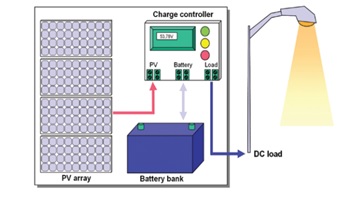Photovoltaics
DEFINITION & TYPES OF STRATEGIES
Concentrated photovoltaic (CPV) technology uses lenses or mirrors to concentrate the sunlight onto a small area of solar photovoltaic (PV) cells to generate electricity. Compared to non-concentrated photovoltaics, CPV systems can save money on the cost of the solar cells because a smaller area of photovoltaic material is required. CPV turns the sunlight directly into electricity, while solar thermal turns the sunlight into heat, and then turns the heat into electricity.The two technologies can sometimes be combined for achieve a greater efficiency.Solar photovoltaic is based on the photovoltaic effect.
- Sunlight reaches the photovoltaic panel and it is absorbed by semiconductor materials (such as silicon) of surface ‘solar cells. Solar cells that are normally used are configured as a large-area p-n junction made from silicon.
- If a piece of p-type silicon is placed in close contact with a piece of n-type silicon, then a flow of electrons occurs from the region of high electron concentration (the n-type side) into the region of low electron concentration (p-type side).
- When the electrons reach the p-n junction, they recombine with holes on the p-type side.
- Electrical charges appear then and this creates an electric field.
- The electric field creates a diode that promotes charge flow (known as drift current) that opposes and eventually balances out the diffusion of electrons and holes.
- This field drives the electrons along the wire providing the electric current to power whatever we want.
Photovoltaic cells are usually made of single-crystal silicon, polycrystalline silicon, ribbon silicon and amorphous or thin film silicon PV modules can be integrated into building facades or installed in the roof. These PV modules have to be installed facing the sky, making the reception of sunlight more efficient. Trackers can be used to follow the sun from east to west and for north to south.
Types of PV Systems
GRID CONNECTED
In this system renewable electricity is fed directly into the properties power supply and use photovoltaic panels which are connected to the utility grid.

OFF GRID
In Off grid systems the electricity produced by the photovoltaic panels cannot always be used directly. The mainly functions of a storage battery in an off-grid photovoltaic system are:

• Energy Storage Capacity and Autonomy: To store energy when there is an excess and to provide it when required.
• Voltage and Current Stabilization: To provide stable current and voltage by eradicating transients.Supply Surge Currents: to provide surge currents to loads when required.
Trend
Market evolution from 2012 to 2017 will depend mainly on developments and the ability of policymakers to maintain market conditions at an acceptable level.
The European market would stabilize first around 16-17 GW in 2013 before growing slowly again to around 25-28 GW in 2017. The global market could top more than 84 GW in 2017. EPIA expects the APAC region (without China) to represent between 10 and 20 GW each year until 2017.
China could add 10 GW of PV installations each year, as announced by the Chinese authorities.

